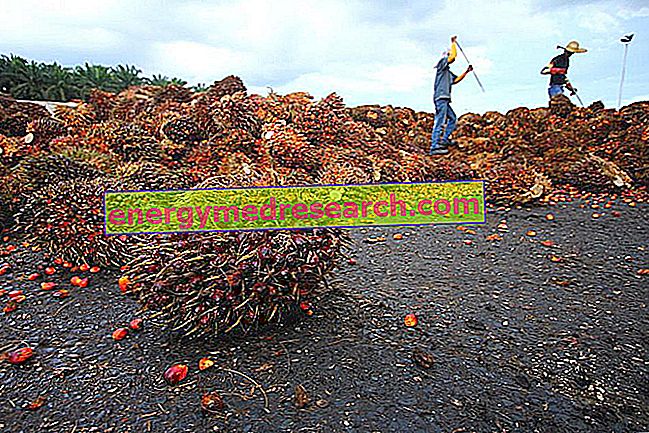
As of 2012, the annual turnover of Indonesia and Malaysia (the two most important producers in the world), was 40, 000, 000, 000 dollars.
Between 1962 and 1982 the relative exports increased from half a million to 2, 400, 000 tons a year and, in 2008, the global production of palm oil and palm kernel oil reached 48, 000, 000 tons. According to FAO (Food and Agriculture Organization) forecasts, global demand for palm oil will double by 2020, to triple by 2050.
In Indonesia
From 2006, when it surpassed Malaysia, Indonesia became the largest palm oil producer in the world, with as much as 20.9 million tons a year. Indonesia expects to double its supply by the end of 2030. At the end of 2010, 60% of national production was exported as "Crude Palm Oil". FAO data show that, between 1994 and 2004, productivity increased by over 400%, with more than 8.660.000 tons of palm oil.
In Malaysia
In 2012, Malaysia, the world's second largest palm oil producer, produced 18, 790, 000 tons of crude palm oil, exploiting approximately 5, 000, 000 hectares of land. Although Indonesia boasts superior production, Malaysia is the largest exporter in the world, with a peak of 18, 000, 000 tons in 2011. China, Pakistan, the European Union, India and the United States are the primary importers of Malaysian palm oil.
In Nigeria
Until 1934, Nigeria was the largest producer of palm oil in the world but, since 2011, it has fallen to third place with approximately 2, 300, 000 hectares of cultivated area. Both the small and the large producers of the nation participated in the development of this sector.
In Thailand
In 2013, Thailand produced 2, 000, 000 tons of crude palm oil, derived from the cultivation of approximately 626, 000 hectares of land.
In Colombia
In 1960, approximately 18, 000 hectares of land were cultivated with oil palms in Colombia and thus became the largest producer of palm oil in the South and North American continent; 35% of productivity is exported as biofuel .
In 2006, the "Fedepalma" (association of owners of Colombian palm plantations), reported that oil palm cultivation was expanding up to 1, 000, 000 hectares. This extension was partially financed by the "United States Agency for International Development" (for the resettlement of the unarmed paramilitary members) and by the Colombian government (which proposed to extend the use of the territory for exportable crops up to 7, 000, 000 hectares within the year 2020). The "Fedepalma" states that its members carry out the cultivation of oil palm respecting all the guidelines of eco-sustainability.
On the other hand, the Afro-Colombian residents claim that some of the new plantations were established after the flight of the population following the civil war, forcibly removing even the remaining people.
In Benin
The oil palm is native to the wetlands of West Africa, which is why South Benin is home to many plantations.
The "Agricultural Revival Program" has identified many thousands of hectares of land that can be used for new oil palm plantations for export.
Despite the economic benefits that could be drawn, non-governmental organizations (NGOs) such as the "Tropical Nature" claim that biofuel production will compete with the national food production of some existing primary agricultural sites.
Moreover, for the same sources, the reclamation of the marshes for agricultural purposes could have an environmental impact to say the least detrimental.
The intention of the "Agricultural Revival Program" is to introduce genetically modified plants and, therefore, it is feared that these may endanger the current cultures of Non-Genetically Modified Organisms.
In Cameroon
Cameroon had started an oil palm production project initiated by Herakles Farms in the United States. However, the program was blocked due to pressure from "Greenpeace", the "WWF" and other national civil society organizations.
Even before the project was interrupted, already in the initial phase of the negotiations, Herakles Farms abandoned the "Round Table" on sustainable palm oil (RSPO). The project was frustrated due to the opposition of the villages and the possible location of the project in a biodiversity point.
In Kenya
The Kenyan national production of edible oils covers about one third of its annual needs, estimated at around 380, 000 tons per year. The rest is imported from abroad, for a cost of around 140, 000, 000 dollars a year and making the edible oil the second most important import article in the country (after oil).
Since 1993, in Western Kenya, the United Nations FAO has promoted a new hybrid palm variety characterized by a wide cold tolerance and a high oil yield. In this way, it was possible to alleviate the national deficit of edible oils by providing a more profitable cultivar; this has led to numerous environmental benefits by moderating the competition of palm trees with other food cultivars and with native vegetation, and contributing to stabilize the soil.
In Ghana
Many oil palm species live in Ghana that could help improve the agriculture sector. Although Ghana boasts more palm species (in addition to local ones, even the so-called "agric"), palm oil is marketed only locally and in neighboring countries. Currently, production is expanding and plantations have become the main investment funds, as it is estimated that Ghana can become an important palm oil production area.



